|
|
 |
 |
 |
|
| insightment:
a luminous prayer wheel |
 |
|
|
This
page describes a theme-related art installation for Burning
Man 2003. It is a collaboration between Aaron Ximm
(me), my wife Bronwyn, and my brother Barnaby Thieme.
Implementation
details are here. Latest news on volunteering is here.
Please write me with any questions or call me anytime at 415.487.9439 (home), 415.637.5347 (cell).
|
|
|
| encountering
the prayer wheel |
|
|
|
Far
out on the playa, a field of many-colored lanterns is encounted.
The lanterns are silent, suspended on bamboo poles at various
hights. From afar they blend into the flickering lights of
our carnival city, and the twinkling stars above. Up close
the flicker of their small lights creates a gently wash of
color on the playa.
The lights
are spread seemingly at random over an area of perhaps thirty
feet in diameter. Seen from above, the installation would
look something ike this:
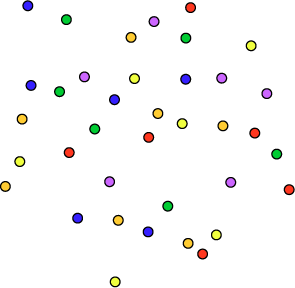
Each
lantern is mounted on a bamboo pole at a height varying from
close to the ground to 8' up.
Each
lantern and has six facets, each of which is covered with
a gel so that the light cast is colored. The gently flicker
light is not particularly bright; at night, it casts a soft
colored aurora on the playa below it. On the deep playa, this
is more than sufficient to create a place that is welcoming
and alive. The lanterns are fixed on bamboo poles, apparently
by rope... the overall feel is austere but natural, plain
but warm, beautiful and quiet. Last year, my very similar
installation was described as peaceful, serene, a refuge,
and Hobbiton-like.
To the
casual observer, that's it....
However,
there is a careful ordering waiting to be discovered by whoever
takes a little time exploring the space...
|
|
|
| inspiration
for the piece |
|
|
|
One
of my favorite aspects of the playa is how it strips space
of its scale references. Illusions and mysteries of scale
abound -- how far is it, anyway, to that sculpture? How big
is that thing over there?
At night
in particular, small point sources of light are very hard
to fix in space. A bright light six feet away and thirty feet
away look quite similar. Is that light a dropped glow stick,
or a rave, or a whole installation I missed...?
I've imagined
many games to play with this aspect of the space. The Prayer
Wheel is my favorite idea so far.
|
|
|
| ancient
principles |
|
|
|
Not
long after I originally conceived of this piece working, I
described it to an architect friend while visiting. Half
way through my description, he sprang to his feet and ran
into the next room. He returned with this print on a postcard,
which he'd gotten early in the week:
|
|
|
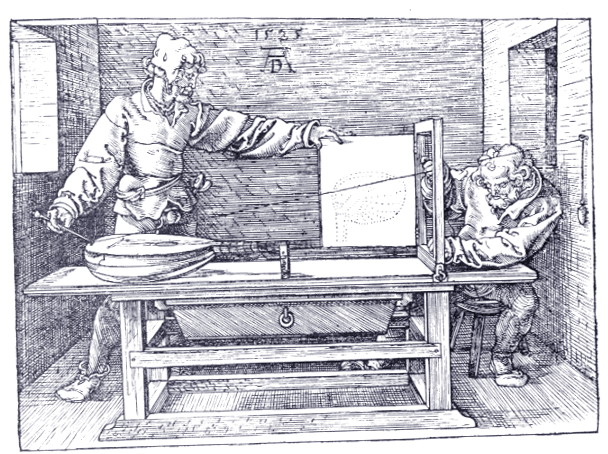 |
|
Drawn
by Albrecht
Dürer (1471-1528), this sketch clearly demonstrates
the principal on which the installation works: perspective
and lines of sight.
In Dürer's
print, we see that a three-dimensional shape can be captured
with a perfect perspective drawing on a real two-dimensional
plane -- a piece of paper, on which he's punched holes. (The
principals he discovered behind perspective drawings are still
taught in Art 101, and are the foundation of three-dimensional
computer graphics of course).
In the
Prayer Wheel, I flip his strategy around. A three-dimensional
arrangement of objects can, in the right circumstances which
obscure perspective, appear to occupy a a two-dimensional
plane: can appear to draw something, in other words. Consider
the old "I'm crushing your head" or "I'm holding
up the Leaning Tower" trick —close one eye and squint,
and you can start to see things as occupying the same plane.
In the
Prayer Wheel, this optical trick is leveraged. From unique
viewpoints, some of the lanterns line up in coherent patterns.
There are five hidden shapes, five letters, viewable
from five specific points regularly spaced around the installation.
Coherence
-- regularity, alignment, color -- forces the viewer to perceive
the lights as a group, even though they are scattered in space.
Humans are very good at detecting patterns and regularity.
Coherence is an even stronger perceptual force when we see
faces or words -- any familiar shape, like a letter.
Consider
the situation of the viewer below:
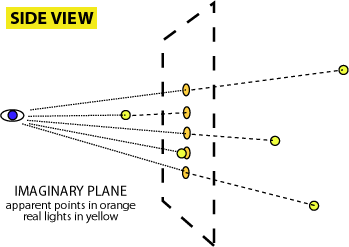
The
yellow circles show where objects (lanterns) are really placed,
at varying distances from the viewer, at various heights..
From our
perspective, looking from the side, they're all over the
place, a random distribution.
But to
the viewer on the left, the lights line up in a neat line.
It's easy to see how the viewer will group them, unconciously,
if they're neatly spaced -- even if that neatness is an "accident'
of a specific perspective, a trick of lines of sight, at a
unique viewpoint.
The key
is that at one viewpoint, s/he doesn't care that some of the
lights are closer than others. We could slide the lights closer
or farther to the viewer, anywhere along the dotted line axes,
without upsetting the perceived line.
Another
example of this principal is how how constellations work:

To
boil it down: the lanterns in the Prayer Wheelmake dot-matrix
letters on imaginary planes, but these secret shapes are viewable
only from special viewpoints. By the magic of perspective
the shapes are not visible from other positions.
|
|
|
|
Burning
Man 2002: sign of light
|
|
|
|
These
ideas were all realized last year in my installation for the
deep playa, Sign
of Light, which you can see here:
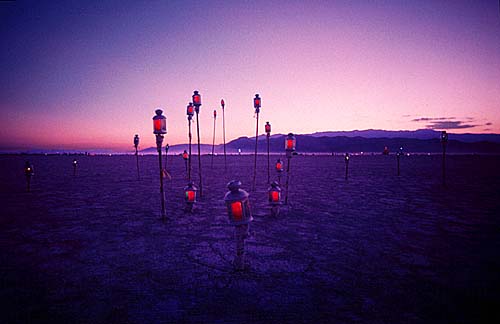
photography
by Fritz Hoddick
The 'secret
shape' in this piece, installed in 2002, was not a letter
precisely, but the Japanese symbol enso, a slightly open or
disjoint circle which often appears in Zen calligraphy.
Though
you can't see it perfectly in this picture, but the circle
appeared only from a unique perspective, from a unique
place. If you sat in the right spot, with the installation
between you and the Man, the lanterns would form the circle-symbol
Enso around him.
There
were hints that this was the case -- even a casual
observer would notice that all the red facets faced
in one direction; but it took a little effort to find the
true, precise ordering. Much of my artwork in all mediums
relies on active attention, a s small effort: in other words,
participation.
Here's
another picture, that shows that from another perspective,
standing a little off to one side, they appear to be more
randomly placed:
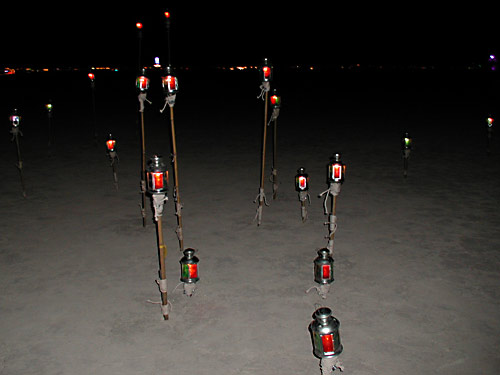
|
F
|
|
| Burning
Man 2003: insightment |
|
|
|
For
this year's piece, the installation is very similar, but about
three times as big. Instead of 23 lanterns it will use about
75.
As described
above, last year's Sign of Light contained only a single 'hidden
character.'
This year's
Prayer Wheel has five juxtaposed symbols to be seen. Each
one can only be see n from a unique, seperate location, as
shown below.
Let's
look again at the pattern of lights introduced at the top
of this page, but with a new understanding:
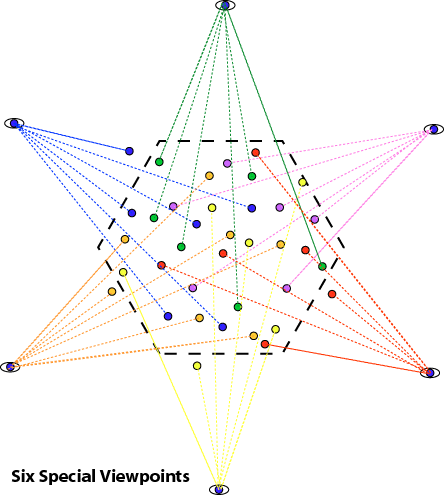
From
each of five special points of view (the graphic shows six,
but I'm too tired to remake it!), the lantern facets of a
specific color pick out one of five characters. One letter,
one color, one unique viewpoint.
To see
the entire message, the participant-viewer must walk around
the entire piece. As each vantage point is approached, a particular
color of lantern-facet will begin to predominate. It's much
easier to see how compelling this is than to describe it --
but as you bike/walk around the piece, it will be clear that
there is something going on, that the arrangement of color
is not accidental.
It will
still take a little patience to find the 'right' spots to
read each letter/character however.
So...
what do they say?
|
|
|
| the
mantra |
|
|
|
I've
spent a fair amount of time thinking about what the secret
message should be. Some constraints:
- The
fewer characters, the fewer lanterns, the simpler, the better.
- Five
messages/points of view is the perfect number. If the imaginary
planes are arranged as a pentagon, instead of a hexagon
as shown, no two sides are parallel. This reduces the crosstalk
-- the chance that one message might be readable from "behind".
The message
I decided on is:
LET GO
As last
year, the circular red O will appear to encircle the Man.
As described
above, each letter will appear from only one position. All
of the lantern-facets done in a particular color will face
in only direction, and as part of a single level.
The message
is as short a mantra as I could realize which resonated as
completely true to my intent.
(Originally
I thought about using Tibetan characters and the common mantra,
Om Ma Ni Pad Me Hum (hence the six-sized shape above), but
I decided that most people would not be familiar enough with
the Tibetan characters in the mantra to see them, especially
if they were crudely realized.)
|
|
|
| the
virtual prayer wheel |
|
|
|
To
read this mantra, one has to walk around the piece, stopping
in five places to read each character in turn.
In doing
so, one inadvertantly activates the piece as a virtual
prayer wheel ~ to spin it, by walking around it, is to
activate its blessing, dispersing it onto the wind. As one
always walks around Buddhist precessional sites clockwise,
the letters will be set up to be read in that direction.
Creating
a virtual prayer wheel appeals to me on many levels. Here
are several:
- There
is a resonance between the message that the secret is hidden
before your eyes, and the fact that the message is hidden
before your eyes;
- The
emphasis on compassion and clarity is one I find overwhelmingly
compelling in these troubled times;
- My
previous installations (sign of light, shown above, and
kolam,
a luminous mandala) were both based on (a) encounters
with Hindu devotion from southern India; and (b) the Zen
symbol Enso for enlightenment. I like the idea of evolving
that thread;
- Walking
around the installation to see what each "color"
spells, one would inadvertantly(?) activate an enormous
virtual prayer wheel. Surprise, you've been blessed!
I'd like
to expand a moment on the last point. In many Buddhist traditions,
walking is a form of meditation. In many versions of Mahayana
Buddhism such as Tibetan, it is considered good karma to send
mantras (prayers) into the world, even through mechanical
means. The most well-known mechanical means in the West are
prayer flags and prayer wheels.
When you
spin a prayer wheel, the mantras inside it and enscribed on
it are "activated" and spread on the wind, dispensing
good karma. When the wind blows across prayer flags, the mantras
inscribed thereon are activated and fly free.
Walking
around a sacred object accomplishes much the same thing; Buddhists
walk around sacred objects in a clockwise direction. (This
also keeps the heart close to the object, and the unclean
left hand farther away...)
From a
relative frame reference, walking around the Prayer Wheel
is staying still, and spinning the world.
Blowing
through the Prayer Wheel, the Black Rock wind will disperse
blessings to the four corners. God knows the world needs some
blessings on the wind these days.
|
|
|
| implementation
details |
|
|
| lanterns |
|
|
|
The piece
will consist of about 75 lanterns (about $6, from Ikea!).
Each lantern
contains a rigid interior wind screen, which in turn surrounds
a small oil lamp.
The lanterns
have six facets, each of which is covered with a colored professional
lighting gel, affixed to the inside.
|
|
|
| mounting |
|
|
|
Each
lantern will be mounted on a bamboo pole, which in turn is
secured to a minimum 2' length of rebar, most of which is
anchored in the playa. Last year we sunk all rebar at least
18" and had no problems with poles falling over, even
in the (admittedly small amount of) strong wind.
Bamboo
is affixed to rebar with multiple lashings of rope.
Lanterns
are affixed to poles via a convenient combination of wire,
bolts and washers, and rope. The lanterns happen to have 3
holes in the bottom, through which long bolts can be anchored
firmly; these in turn 'grasp' the top of the bamboo on three
sides like pincers. The resulting structure can be made very
immobile using 8' of rope and if necessary a little armature
wire or similar.
Last year
we had no lanterns come off poles.
|
|
|
| lamps |
|
|
|
Lamps
last year were oil lamps well sheltered from the wind; this
tactic is much preferable to candles and will be used again
this year.
This
year, we'll be using self-contained oil cartridges instead
of re-filling small glass oil lamps. This will eliminate the
need to refill lamps by hand, greatly reducing the necessary
daily work of tending to the much larger number of lamps in
this year's piece.
Experience
last year shows that a microscopic wick produces the appropriate
1/4" or smaller flame.
Oil lamps
will be lit each dusk and when necessary blown out each dawn
to preserve lamp oil.
One additional
advantage of using self-contained, disposable plastic oil
lamp cartridges is that no bulk or loose fuel must be kept
and protected.
However,
as with last year, a fire extinguisher will be maintained
in all locations where the lamp cartridges are stored and
transported.
|
|
|
| |

